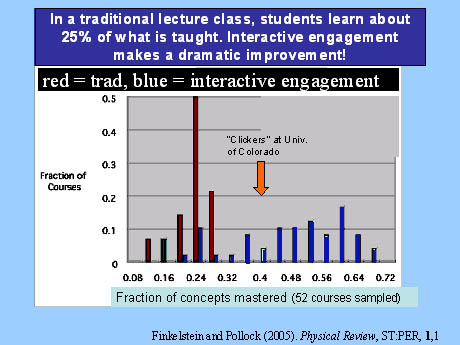Using clickers correctly makes an ENORMOUS difference in how much learning takes place in a class and how much faculty and students like the use.
Why teach interactively, having students discuss conceptual questions during lecture? Because in a standard lecture class, no matter how good the teacher, students typically only master about 25% of what is presented. (Hake, 1998). A summary in linked here.
A summary of Tips for Successful Clicker Use is linked here, and it is downloadable in pdf format here. It is based on research at the Univ. of Colorado, which has 17,000 clickers in use as of 2010, and elsewhere in the US, where around two million clicker are in use. The Tips address the misconception that clickers produce learning. Claiming that is like claiming "chalk produces learning" (remember chalk?). Data DO show that clickers can be used in a number of ways that augment teaching tremendously. They also show the most common causes of failure in clicker use, and those are in the Tips , too.
![]() Some short but VERY USEFUL videos showing the power of peer instruction and clicker use,
with faculty and student interviews, from the Carl Wieman Science
Education Initiative are linked to the image at left. Check them out!
Some short but VERY USEFUL videos showing the power of peer instruction and clicker use,
with faculty and student interviews, from the Carl Wieman Science
Education Initiative are linked to the image at left. Check them out!
A cute 20 second video that shows how context affects meaning and understanding is linked here.
CU has a large, new, dynamic Physics Education Research group, famous for its outstanding on-line demonstrations (phet.colorado.edu) and varied research, including that of Nobel Laureate Carl Wieman who has devoted himself full time to education research.
 This book is being revised, since we have learned so much about
This book is being revised, since we have learned so much about

clicker use in the last 4 years. But it remains true that NO lecture
comes close to the learning interactive teaching provides.